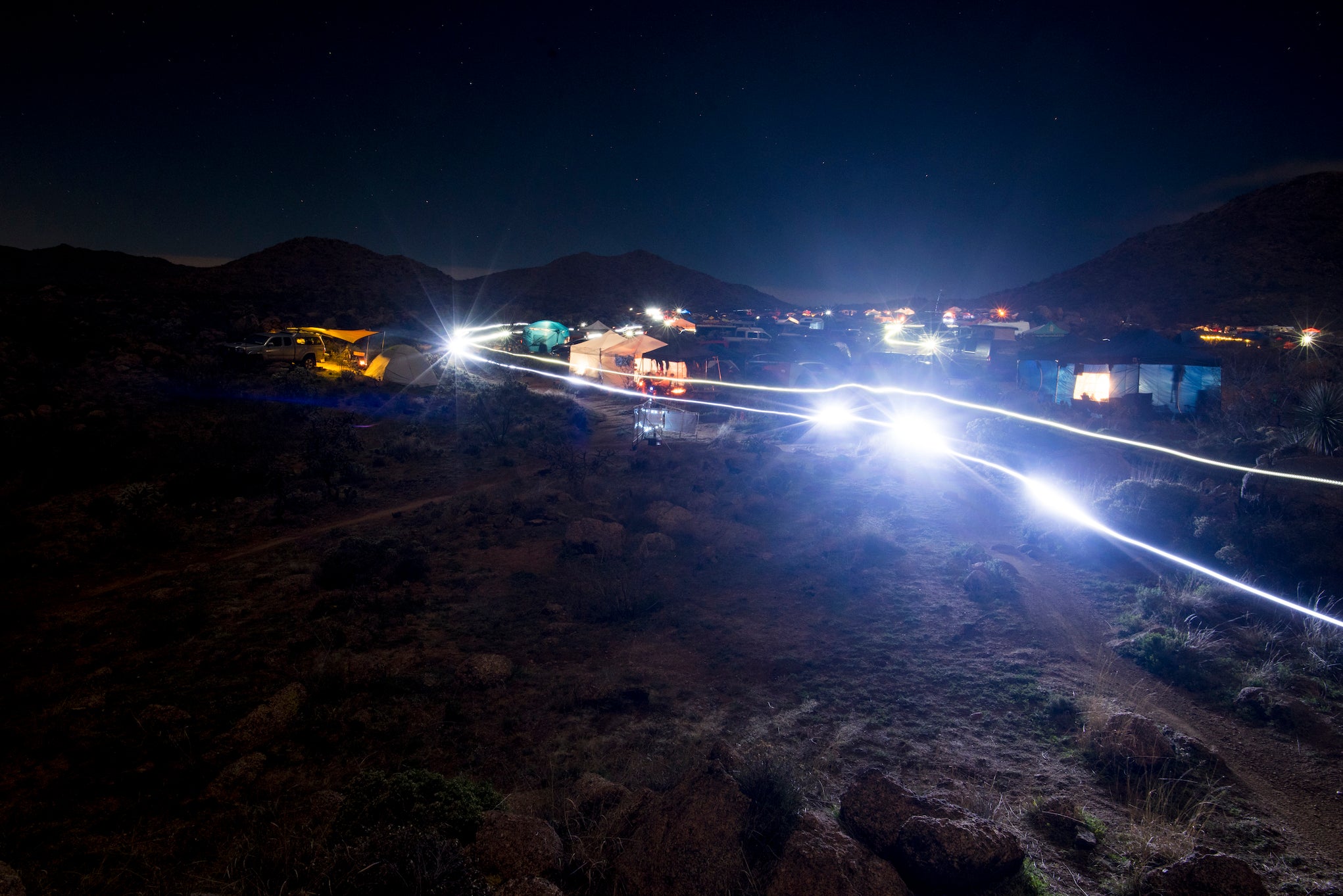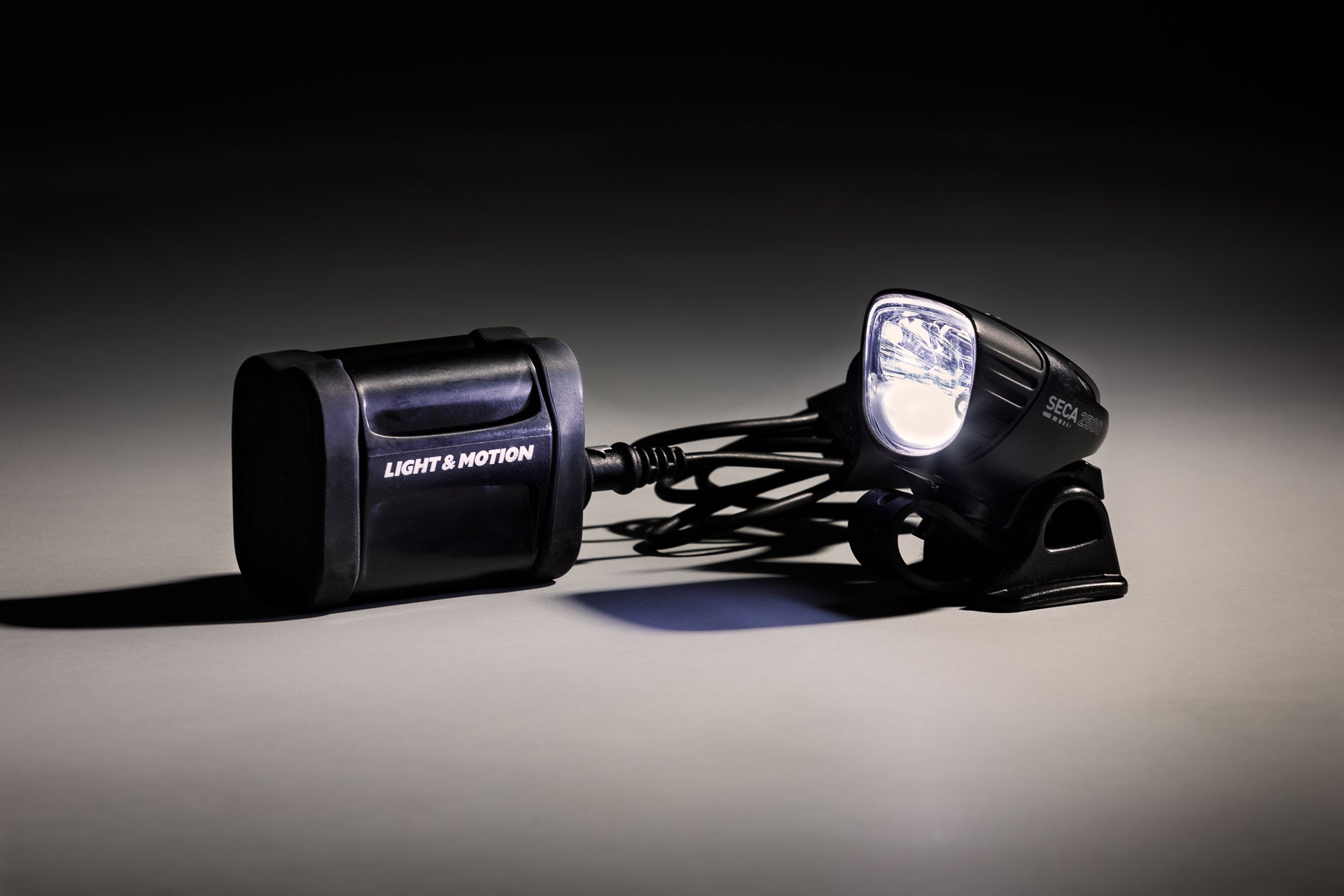As I was flying through the Arizona desert, avoiding saguaro and cholla cacti lining the singletrack trail, my mind wandered for just a moment. It had been about a decade since I’d done this. I last raced a 24-hour mountain bike race around 2009. A lot had changed since then.
Back then at the now-defunct 24 Hours of Moab, I was on a steel singlespeed. I was racing with a group that was just there to party. My light was hopelessly crappy, and it died at some point on one of my night laps. Now, in 2019 at 24 Hours in the Old Pueblo, I was geared up with a true race bike, roped in last-minute onto a four-person team organized by multi-time national champion Jeremiah Bishop. My light? It was a super-powered Light & Motion Seca.
 Every February, mountain bikers flock to Tucson, Arizona for 24 Hours in the Old Pueblo. Photo: Brian Leddy
Every February, mountain bikers flock to Tucson, Arizona for 24 Hours in the Old Pueblo. Photo: Brian Leddy
During the event, all I could think about was how much better it was to race with that light. What I didn’t realize was that a proper riding light would have a far bigger impact on my weekly riding come fall when the days got shorter.
With a good riding light, I felt like I was playing with house money. All of a sudden, dark after-work hours became a great time for mountain biking, even if it was a bit brisk. Night riding became a fresh challenge on familiar trails and a great way to fight off the winter solstice doldrums.
Whether you want to ride trails through the dark days of winter or even try your hand at a 24-hour race with some friends, night riding is a fun new adventure. So, I decided to call Daniel Emerson, CEO of Light & Motion, to learn a little more about the technical aspects of riding lights.
What are lumens and how many do you need?
When you replace a lightbulb in your home, you refer to a bulb’s wattage. But most bike lights are measured in lumens, not watts. What gives?
Nearly all modern bike lights use LEDs. Those light-emitting diode bulbs are becoming increasingly efficient, meaning they use the same amount of wattage but produce more light. Wattage simply measures power to the bulb.
“Lumens were developed specifically for the human eye,” says Emerson. “We humans can only see certain wavelengths of light. Lumens are only wavelengths of light useful specifically for humans.”
Although you can ride with fewer lumens, Emerson recommends a minimum of a 1,000-lumen light for most mountain bike trail riding. This will provide enough light to easily see the trial and obstacles in total darkness.
Does light shape matter?
Lumens are an easy apples-to-apples comparison. However, on the trail, a light’s beam shape can also greatly impact how your eyes perceive what’s ahead — or in your periphery.
“As we start to bring in more light, we tend to spread it,” Emerson says. “With 1,000 lumens, you can see far ahead, but you won’t be able to see much to either side.
“Our of top-of-line Seca has four LEDs — one in the center is literally plowing light down the center, and the two to the side are angled off-center. Instead of round spot down the trail, you’re getting an oval shape. The bottom LED spreads light in a near field, illuminating the trail near to you to see where you want to steer like on a slow corner.”
Having ridden with my own Seca for a while, I can confirm that the beam shape does make a difference. With little head motion, it’s easier to glance ahead to the exit of a corner or to see a small rock move right in front of me.
 Light & Motion's Seca Race headlight. Photo: Chris Motta | The Pro's Closet
Light & Motion's Seca Race headlight. Photo: Chris Motta | The Pro's Closet
Can you have a light that is too bright?
If money is no object, it’s easy to assume that more is always better in terms of lumens. However, Emerson cautions that too much light can lead to what he calls the “Snowball Effect.” Essentially, a too-bright light can interfere with your eye’s natural ability to compensate for low light, temporarily blinding you.
“If you project a really bright light down the trail, and your eye adjusts for that bright light, the minute you look aside you’re blind, it destroys your night vision,” he says. “With our beam, we have a very even fall-off. It is bright enough in the center to see well, but when you look to the side, your pupil hasn’t completely dilated. It’s a much more comfortable light to ride with, and you can see much more broadly.”
Light & Motion doesn’t go beyond 2,500 lumens for its bike lights. In part that’s because Emerson and his team feel the beam shape is more important. Also, he notes that lights with more lumens usually require heavier batteries.
“I like the Seca Race,” he says, which at 2,000 lumens is 500 lumens less than the brightest option, the Seca 2500. “While more lumens are nice, I like light weight and I can always add a second battery for back-up. The heads are the same weight, it is the battery that adds the heft.”
Will batteries die in the cold?
Anyone who has had to jump-start their car in the dead of winter can confirm that cold temperatures are hard on batteries. If you night ride in places like Florida or Southern California, this might not matter, but in temperate regions, night rides can get kind of cold. The good news is, if you avoid storing your batteries in the cold, you should be okay.
“You start to affect battery performance below freezing, you affect the run time,” Emerson says. “You shouldn’t leave it outside, like in the car when you’re not using it. The colder it gets, you could get half the battery life. But when it’s in use, it’s warm, generating heat internally.”
Handlebar mount or helmet mount?
You generally have two options to mount bike lights: your handlebars or your helmet. There are tradeoffs and benefits to either placement, so it boils down to personal preference.
A helmet light illuminates exactly where you are looking and the light doesn’t bounce around quite as much on rough trails, compared to a bar mount. Plus, you can pretend to be a coal miner. Mounting a light on your bars takes the weight off of your head, and avoids annoying wires that go down your back to an external battery (depending on your light). Bar-mounted lights are also perfect for pretending you’re racing the Baja 1000 … braap!
Serious night riders often pair a helmet and a bar light, and often one is more powerful than the other.
“[World champion] Rebecca Rusch likes the powerful light on the helmet and just a pointer light on the bar,” Emerson adds. “I prefer the big broad Seca on the bar because I don’t want to deal with wires coming down my back.”
Most lights can mount on either your handlebars or helmet, so you can try both options. Eventually, you might opt for a light on both helmet and bars, but for starters, just one will be fine. I prefer a helmet-mounted light because it casts light exactly where I want it. It’s also less bouncy than a bar-mount, but I do need to be careful not to snag it on low-hanging branches.
How to get started
I realize I’m quite spoiled to have a 2,000-lumen Seca that makes me feel like I’m being chased by a trophy truck (sorry… I’ve got Baja on the brain). If you’re dabbling with night riding, it might not make sense to get a $250 race light for starters. Fortunately, there are some more affordable options that are near that 1,000-lumen starting point Emerson recommended.
Light & Motion makes the 1,200-lumen Taz 1200 Black Raven for $130. In that same lumen range, NiteRider offers the Lumina 1200 Boost for $110. If you find yourself adapting to the nocturnal life, you can always upgrade to a more powerful light and continue to one of those lower-power lights as your secondary or backup light.
Whatever light you end up with, make sure you also find a good crew of friends to ride with. Night rides are always more fun (and a little safer) with fellow riders who match your ability level and sense of adventure. Who knows, maybe they’ll talk you into a 24-hour race someday.

